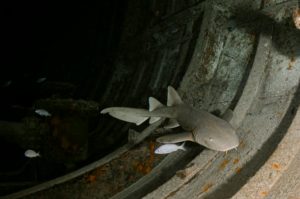Researchers made the discovery while studying nurse sharks. Like humans, the marine predators rely on the pancreas to control blood sugar and produce digestive enzymes. But they also use it to make antibodies and fine-tune certain white blood cells against microbial threats, according to a study published last month in The Journal of Immunology. Sharks may not be the only animals to enlist the pancreas for defence, the study implies, and other organs could take on unexpected immune functions.

Given that sharks and their relatives have been around for more than 400 million years, it’s no surprise they sport a strong immune system. Though they lack lymph nodes and some other immune organs that help detect and fight microbial invaders, they produce many of the same types of protective cells and deploy antibodies, including unusual miniature varieties.
“It’s a compelling paper,” says evolutionary immunologist Robert Miller of the University of New Mexico. The results suggest these aquatic animals “have come up with an alternative solution where they use an existing organ to do a different job
To determine whether the pancreas manufactures antibodies like previous studies suggested, the researchers prodded one shark’s immune system with foreign particles and another’s with the COVID vaccine.
A few weeks later, the scientists detected antibodies specific to the injected antigens in the animals’ pancreas, suggesting that the organ indeed produces these proteins. Sharks may release antibodies made in the pancreas into their intestines to guard against pathogens, the authors speculate.
When graduate student Thomas Hill examined tissue samples from one of the sharks, he noticed immune cell clusters in the pancreas that usually show up in secondary lymphoid organs in sharks and other animals.
The gatherings serve as arenas where B cells, the immune cells that crank out antibodies, compete against each other and the best fighters against a specific pathogen are chosen
Whether the human pancreas also takes on similar functions is unknown. “If the organ served as a staging ground for immune cells in ancient vertebrates such as sharks it could help explain why the human pancreas is susceptible to inflammation, a condition that is sometimes fatal, says University of Maryland School of Medicine immunologist Helen Dooley.
When Hill showed the results to Dooley, she thought they had to be wrong. “My first reaction was, ‘Are you sure somebody hasn’t scrambled the tissue samples?’” she says.
They decided to test whether the pancreas plays a defensive role in the nurse shark (Ginglymostoma cirratum), a species whose immune capabilities Dooley has been studying for more than 20 years.
The results could shed light on the operation of our immune system, says viral immunologist Matthew Koci, who wasn’t connected to the study. “The more we find out about how the immune system works in other species, the more bright ideas we might get about the immune system in humans. ”Most animals — including humans — use their pancreas to control their blood sugar and produce digestive enzymes.
But in sharks, the organ has an additional, surprising function: It’s a critical part of the immune system, making antibodies and fine-tuning certain white blood cells against microbial threats.
Like humans, the marine predators rely on the pancreas to control blood sugar and produce digestive enzymes. But they also use it to make antibodies and fine-tune certain white blood cells against microbial threats, according to a study published last month in The Journal of Immunology. Sharks may not be the only animals to enlist the pancreas for defence, the study implies, and other organs could take on unexpected immune functions.
Whether the human pancreas also takes on similar functions is unknown. If the organ served as a staging ground for immune cells in ancient vertebrates such as sharks, Dooley says, it could help explain why the human pancreas is susceptible to inflammation, a condition that is sometimes fatal.
Abstract from an article written by Mitch Leslie published in Science Advisor
